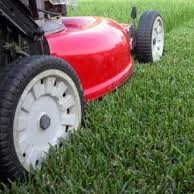
Hose
If you can afford it, buy two hoses; there may be times you want to multi task, such as running a sprinkler while you wash your car, fill a pool or rinse a pet. Measure the various distances you may need a hose to reach and buy hoses a few feet longer than you need. Purchase a nozzle attachment that lets you turn your hose into a sprayer. This will help with watering and debris removal.
Sprinklers
If your lawn doesn’t come with an irrigation system, invest in some sprinklers to help keep your lawn watered and green. Don’t go cheap; $3.99 sprinklers aren’t worth the hassle if they break, leak and cause you to go back to the store for a replacement. A good lawn sprinkler can last you for years. Look for a timer you can place on your faucet for convenient watering. You’ll have to turn your faucet, but a timer will prevent overwatering if you forget to turn off your sprinklers after your lawn gets adequate water.
Lawn Mower
If you’re doing your own grass cutting, purchase a self-propelled mower to make weekly mowing easier. Buy a mower that gives you the option to bag clippings or mow without one to mulch your grass. If you have a larger lawn, you may want a tractor or zero-turn radius mower. Tractors are better suited for hilly terrain, while ZTRs provide more maneuverability in yards with a number of tight spaces.
Shovels
Invest is a good spade or two, including square and round tips shovels. Buy a small hand tool for getting into tight spots or moving small amounts of dirt.
Clippers
Buy small hand clippers for cleaner cuts and healthier plants. Using large hedge clippers on shrubs, bushes, vines and plants will create ragged cuts that stress plants.
Gloves
Invest in a good pair of work gloves to keep your hands clean and reduce injuries. Working with pinecones, rocks, sticks and other debris can results in nicks, cuts, splinters and other wounds. Work gloves also provide a non-slip grip as you work with heavy objects and help prevent blisters. You may also surprise bugs, wasps or other pests as you’re working in the dirt, and gloves will prevent bites and stings.
Bags
Have an ample supply of heavy-duty plastic and paper bags for refuse, such as grass clippings, leaves and sticks. Check your city’s or town’s website for their refuse policy and make sure you use the correct bags to dispose of yard debris.
Ladder
If you’re thinking of borrowing a neighbor’s ladder the few times you’ll need one, you may be surprised how often you’ll have to use one. You may need to clean leaves from gutters, get on your roof to remove debris, power wash roof tiles or gutters, trim high tree branches or hang Christmas lights. Invest in a sturdy, stable ladder that will support not only your weight, but also any items or items you bring up with you. Measure carefully before you buy; a ladder that’s even a foot or two short can be frustrating and lead to hazardous situations as you try to boost yourself that extra distance.
Gas Container
Purchase a small container for buying gas for your lawn mower or other items that require gas. Don’t use a homemade container; most gas stations won’t let you fill one.
Rake
Even if you don’t have trees or leaves to remove from your lawn, a rake comes in handy for removing a variety of debris. In addition to a traditional rake, consider buying a thatch rake if you intend to manage your own lawn. Each fall, you’ll want to thatch rake your lawn, removing excess grass clipping, leaves and other debris that can build up and choke your grass. Thatch raking is especially important if you plan to re-seed in the fall.
Spreader
If you plan on doing your own fertilizing and seeding, purchase a spreader. This will help you quickly and evenly apply weed and feed, pre-emergent, fungicide or seed throughout the year. You can purchase a small hand seeder, which you crank with a handle as you walk, or a larger seeder with wheels you push in front of you.
http://www.ask.com/explore/essential-lawn-equipment-new-homeowner






